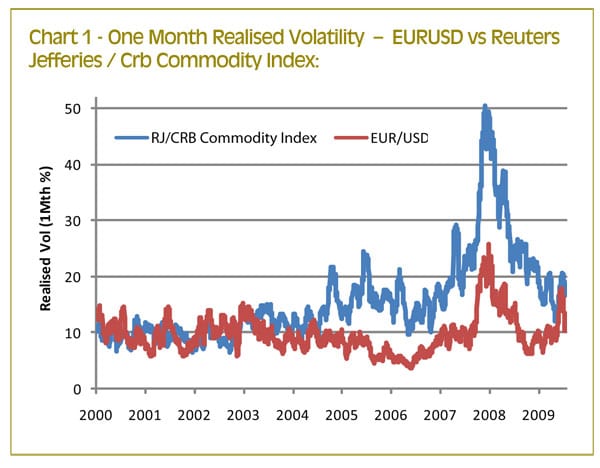by Kevin Lester, Director of Risk Management and Treasury Services, and Alexander Haigh, Financial Risk Management Consultant, Validus Risk Management
Nothing focuses attention on an organisation’s financial risk management capabilities like a bout of sustained market volatility. When financial markets destabilise, as we saw in 2008 and 2009, risks that may once have been seen as a low priority by many organisations, suddenly become much more visible. Both foreign exchange and commodity prices have witnessed dramatic increases in market volatility since 2007 (see chart 1 below), creating an increased requirement for corporate treasurers to ensure that these risks are being effectively managed.
A recent study by Accenture[1], the international management consulting firm, revealed that 35% of corporate executives surveyed believe that commodity price fluctuations have the potential to cause the greatest increase in risk to their firms (a significantly higher percentage than those who listed other factors such as decreased credit availability and liquidity risk). As a result of this focus, many corporate treasurers have become more concerned with ensuring that firm-wide financial risk is managed efficiently and effectively, incorporating commodity risk management into their current treasury risk management strategy. For those corporate treasurers already used to managing FX and interest rate risk, this has led to a focus on a more integrated financial risk management strategy. This type of strategy considers both the unique characteristics of commodity markets themselves, as well as the complex relationship between FX and commodity price risks that must be considered when implementing a robust hedging strategy.

The importance of an integrated approach
Traditionally, FX and commodity price risks have been managed independently within many organisations. There are a number of reasons for this segregation, perhaps the most important of which is the fact that responsibility for commodity risk management is often located in a different part of the organisation (e.g., the purchasing department) from FX risk management. Even when corporate treasury is responsible for both FX and commodity price risk management, this does not necessarily lead to an integrated approach that is based upon a holistic view of financial risk. Such an approach should take into account both the direct (causal) and indirect (correlational) relationships present between a company’s commodity and FX exposures.
Sign up for free to read the full article
Register Login with LinkedInAlready have an account?
Login
Download our Free Treasury App for mobile and tablet to read articles – no log in required.
Download Version Download Version




























